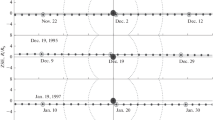Abstract
The two-position radio sounding of the solar wind by the Galileo and Cassini spacecraft has been first performed. These spacecraft followed the Sun from east to west from May 12 to 24, 2000 and sounded the regions spaced in radial directions by several millions of kilometers. Stable correlation has been revealed between fluctuation effects detected in spatially spaced radio-sounding paths of disturbed plasma structures of the coronal mass ejection (CME) type. The radio effects have been found to correlate also with the data on the solar wind density near the Earth orbit. It has been shown that the two-position radio-sounding method together with the data on solar radiation in the X-ray and optic ranges and with the results of local plasma measurements provides information on the structure and velocity of the propagation of CMEs from the photosphere to the Earth orbit. In the most powerful event recorded on May 13, 2000, the CME velocity at the heliocentric distances of about 15R ⊙ (R ⊙ is the solar radius) reached 1200 km/s. At (15–25) R ⊙, the velocity was about 1300 km/s. At distances larger than 25R ⊙, disturbance was decelerated from 1300 to 450 km/s near the Earth orbit.
Similar content being viewed by others
References
N. A. Armand, A. I. Efimov, and O. I. Yakovlev, “A Model of the Solar Wind Turbulence from Radio Occultation Experiments,” Astron. Astrophys. 183, 135–141 (1987).
N. A. Armand, A. I. Efimov, L. N. Samoznaev, et al., “Spectra and Cross-Correlation of Radiowave Frequency Fluctuations during Sounding of the Near-Sun Plasma with Spacecraft Signals,” J. Commun. Technol. Electron. 48(9), 970–982 (2003).
A. I. Efimov, I. V. Chashei, L. N. Samoznaev, et al., “The Outer Scale of Solar-Wind Turbulence from GALILEO Coronal Sounding Data,” Astron. Zh. 79(7), 640–652 (2002) [Astron. Rep. 46(7), 579–590 (2002)].
A. I. Efimov, L. N. Samoznaev, M. K. Bird, et al., “Solar Wind Turbulence during the Solar Cycle Deduced from Galileo Coronal Radio-Sounding Experiments,” Adv. Space Res. 42(1), 117–123 (2008).
D. Morabito, “Solar Corona-Induced Fluctuations on Spacecraft Signal Amplitude Observed during Solar Superior Conjunctions of the Cassini Spacecraft,” Radio Sci. 42, RS003425 (2007).
D. Morabito, “Solar Event Signatures Impressed upon Spacecraft Radio Signals,” in Proceedings of the American Geophysical Union, 2002.
R. J. Woo, W. Armstrong, M. K. Bird, and M. Paetzold, “Variation of Fractional Electron Density Fluctuations Inside 40R s, Observed by Ulysses Ranging Measurements,” Geophys. Res. Lett. 22, 329–332 (1995).
Author information
Authors and Affiliations
Additional information
Original Russian Text © A.I. Efimov, N.A. Armand, L.A. Lukanina, L.N. Samoznaev, I.V. Chashei, M.K. Bird, 2008, published in Solnechno-Zemnaya Fizika, 2008, Vol. 12, No. 1, pp. 114–118.
Rights and permissions
About this article
Cite this article
Efimov, A.I., Armand, N.A., Lukanina, L.A. et al. Investigation of coronal mass ejections by the two-position radio sounding method. Geomagn. Aeron. 49, 1165–1169 (2009). https://doi.org/10.1134/S0016793209080258
Received:
Published:
Issue Date:
DOI: https://doi.org/10.1134/S0016793209080258




